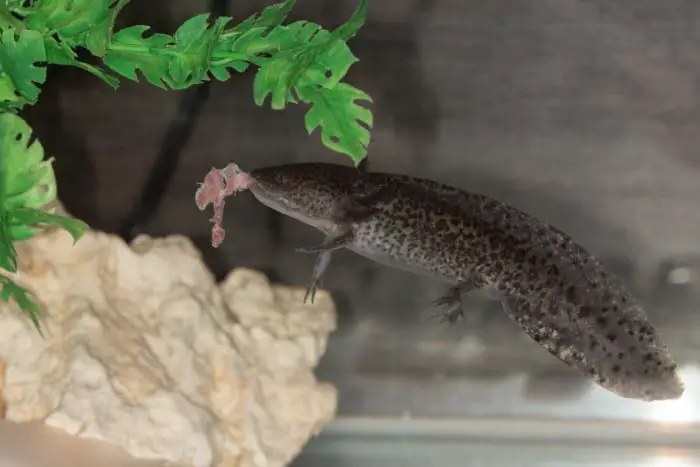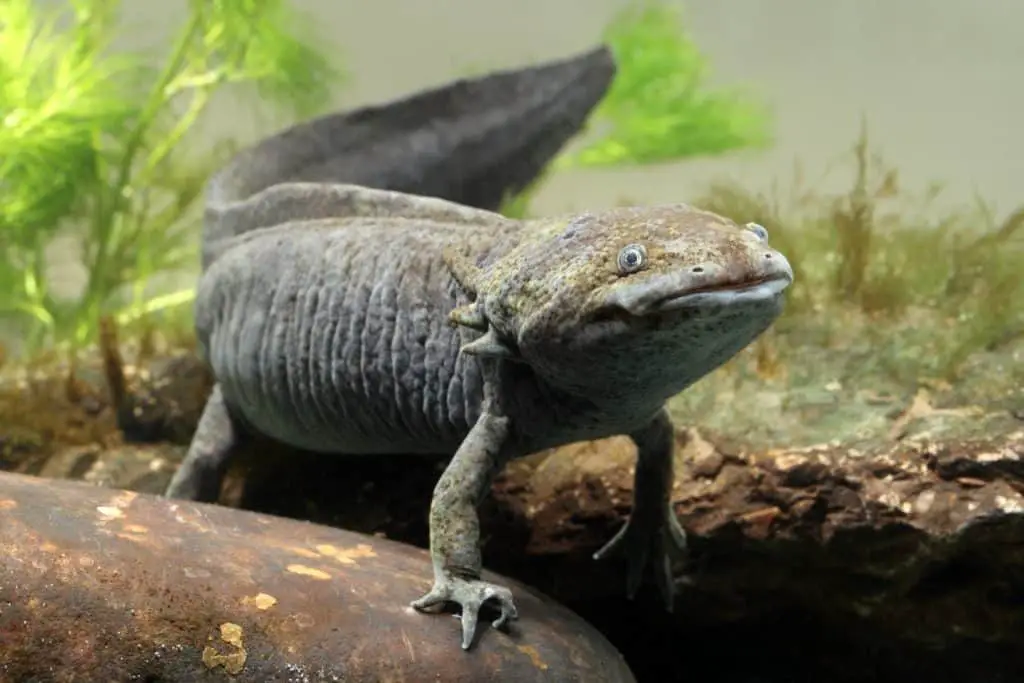As an Amazon Associate we earn from qualifying purchases. The Witty Fish is reader-supported and we hope you love the products we recommend!
Deciding what Axolotl food to offer is a major part of keeping these ancient-looking amphibians alive and healthy. While they aren’t difficult to feed Axolotls won’t always accept the foods you offer.
And some of the food they will accept may not be the healthiest around. Fortunately, this guide to Axolotl feeding will help you make decisions that keep your pet healthy and vigorously growing!
Prepared Axolotl Food Options
Prepared food is a little tricky because like all amphibians Axolotls are predators with an eye for movement. The straightforward sinking motion of flakes and pellets won’t always elicit a feeding response. Oftentimes the Axolotl won’t even realize you’re trying to feed it unless it’s already been trained to eat prepared food.
The best way to train your Axolotl to eat prepared food is to offer it with tongs or press it into pieces of meat and other standard fare. Eventually the Axolotl will associate the smell and taste of pellets with feeding and will take sinking pellets without further enticement.
However, not all prepared foods are created equally. Soft fish and reptile pellets are best. Any sort of hard prepared food should be avoided, including most aquarium fish pellets.
Axolotls cannot chew their food and will simply swallow pellets whole. Once ingested hard pellets absorb water in the gut, which leads to digestive issues. If you can only find hard pellets then pre soaking them in water for 5 to 10 minutes makes them more digestible.
Also spend time reading the nutritional labels on your potential purchase. As carnivores Axolotls have little use for the carbohydrate-rich starch fillers (wheat, corn, potato, etc) used in standard fish and turtle pellets. Choose brands with fish meal, salmon, shrimp, and other meaty ingredients listed first!
Flakes are also good only for baby Axolotls. But even for them small meaty items and pre soaked pellets are much better. Flakes are quite messy and tend to disintegrate and foul the water before they get consumed.
Live Axolotl Food Options

Live prey are by far the best option for Axolotl food. As ambush predators they are constantly trying to sense the movement of nearby creatures. Anything smaller than them is a potential meal, even other Axolotls!
Most pet stores carry feeder fish, shrimp, and insects. For young Axolotls feeder guppies, ghost shrimp, and minnows are inexpensive and sized perfectly for them. As they mature they can graduate to feeder goldfish. Terrestrial insects like crickets, roaches, and mealworms are also great for variety and can be offered on feeding tongs.
If you have the space for a second aquarium I recommend keeping a stock of feeder fish or crickets on hand as Axolotl food in case you can’t get to the store. Also, you can treat them for parasites and gut load them.
Gut loading prey is a practice common to reptile and amphibian keepers where you offer the prey nutritious food right before feeding them to your pets. By doing so your pets take in the extra nutrition from their prey’s pre-digested food.
Earthworms and nightcrawlers are also excellent for Axolotls of all ages. They thrash enticingly and, unlike fish or shrimp, are high in fatty calories. However you’ll want to offer them sparingly as a result. Baby Axolotls can be offered Tubifex worms instead but remember the high fat content!
They will also snap at live Brine Shrimp and Daphnia, though you’ll want to offer them via pipette since these aquatic creatures will swim all over the tank.
Feeding Axolotls Fresh and Frozen Meat
Live prey gets the best response and are a whole food in terms of nutrients. By “whole” food, I mean the Axolotl is also getting nutrition and roughage from scales, bones, organs, and other parts of the prey.
However they aren’t always convenient to keep on hand and no one wants to be making constant runs to the pet store for live food. Fortunately, mixing in fresh or thawed meat is perfectly acceptable so long as you follow some simple guidelines!
Grocery store muscle meats are the easiest to find however they are also the least nutritious choices for any carnivore. Appropriately sized strips of chicken, fish, and beef are all fine and can be kept frozen until you’re ready to use them.
Organ meats are richer in vitamins and minerals and less expensive but much messier. Beef heart, liver, cubes of gizzard or kidney, and other bits of offal are good but you’ll likely need to be doing water changes more frequently.
Any fresh meat should be offered by hand or on feeding tongs. Simply wiggle the item enticingly before the nose of your Axolotl and it will snap at it eventually.
Remove any unconsumed meat or offal to keep it from rotting and causing ammonia levels to spike. And make sure the meat is entirely thawed! As cold blooded animals Axolotls are only as warm as their environment. Any ice contained in the meat can have deadly consequences if ingested.
How Much Should I Feed My Axolotl?

Like most animals Axolotls will gorge themselves if given the chance. Prey doesn’t come around very often in the wild. However this poses a problem in captivity since food is far more abundant.
While they will accept food daily Axolotls should only be fed 2 to 3 times a week. Not only are they cold-blooded but they are sedentary (slow moving) as well. As juveniles they can be fed 4 to 5 times a week but you still need to skip a day here and there.
When overfed Axolotls not only put on massive amounts of weight but poop even more. The extra fecal matter puts a strain on the filtration even more and leads quickly to poor water quality.
Ammonia, nitrite, nitrate, and populations of bacteria and fungi all skyrocket when the water is constantly being fouled by these messy predators.
Give them enough food that their belly gets noticeably rounder and then give them 1 to 2 days to digest. Younger Axolotls are growing constantly so you should be feeding more often but even then not every single day.
Axolotls have slow metabolisms and digest their food gradually. When kept in heated conditions they need feeding more often but also create more waste. Aquarium temperatures should remain around 60-74°F at all times.
When healthy and kept cool an adult Axolotls can go a month without eating! So it’s really not difficult to keep them fed; the challenge is ensuring they don’t get too fat!
Final thoughts on feeding your axolotl
Axolotl food comes in all sorts of shapes and flavors. From live prey to canned pellets the Axolotl keeper has dozens of convenient options to choose from. Lastly, I recommend providing variety for not only the best nutrition but keeping things interesting for you as well!





